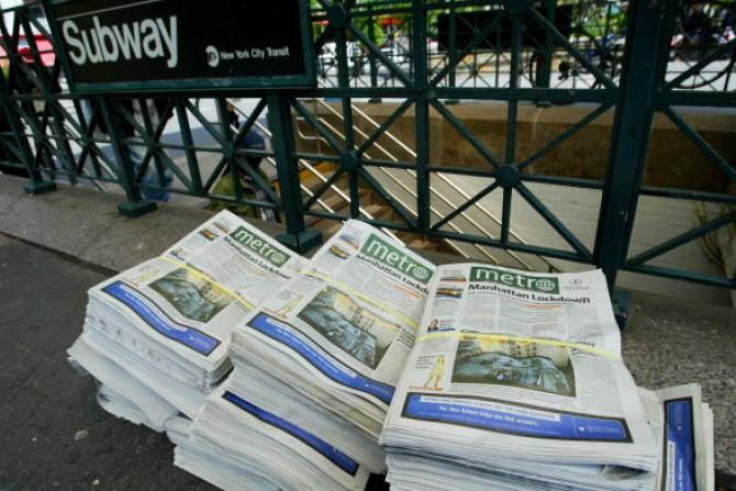NYC Subway Officials Move To Crush Last Vestige Of Newspaper Distribution

In a blow to one of the last viable models of newspaper distribution, New York City’s Metropolitan Transportation Authority has signed off on a plan to stop “hawkers” from handing out free daily newspapers in the city’s subway system. The proposed move, approved Wednesday by the MTA board, threatens to significantly diminish the papers’ visibility at a time when traditional newsstand sales have all but evaporated.
For more than a decade, two free newspapers — amNewYork and Metro New York — have competed for the attention of New York City commuters across the vast underground network; and to do so, they’ve relied on armies of vocal vendors who peddle their products and ensure that any rider who wants one — and presumably many who don’t — gets a copy.
But on Wednesday, the MTA board approved a proposed licensing agreement that would do away with the hawkers in exchange for lifeless newspaper racks. The nonexclusive agreement, valid for up to six years, would allow for the installation of uniform racks at approved locations throughout the subway system and would prohibit amNewYork and Metro from distributing their papers in the subway by any other means.
An MTA spokesman confirmed with International Business Times that, per the agreement, hawkers will no longer be able to hand out the papers in subway stations or even outside subway entrances. Officials for the agency have long criticized the hawkers, who they say create safety hazards by interrupting the flow of commuters and leaving bundles of newspapers unattended. The MTA said discarded newspapers have led to an increase in track fires.
It’s unclear if the papers’ parent companies have signed the agreement or if they plan to push back. A representative for Newsday LLC, which owns amNewYork, declined to comment. Representatives for Metro International did not respond to repeated requests.
John Murray, vice president of audience development for the Newspaper Association of America, said it’s not uncommon for newspaper companies to reach compromises with city agencies and municipalities over distribution methods, even to their own detriment. While an outright ban on newspaper hawkers would likely stir the ire of free speech advocates, newspaper companies, many of which are already struggling to make ends meet, are typically not eager to enter into pricey court battles. Agreements like the one the MTA is proposing ensure that they are still given access but restrict the means by which they can distribute.
The loss of the subway hawkers, whose vocal pleas for readers have become a familiar sound to tube-bound New Yorkers, would likely have a negative impact on the papers’ circulation numbers, which in turn could affect advertising rates. AmNewYork boasts the highest daily circulation of any tabloid-sized paper in the city, with an average of 335,900 copies distributed each weekday, according to its 2014 media kit.
“The hawkers are still very valuable, in particular for free-distribution newspapers,” Murray said. “In many cities without the hawkers, the distribution is below that critical mass and you don’t have the scale that you need from a business sense.”
“You don’t generate an audience as large with racks,” he added.
With the proliferation of smartphones, tablets and e-readers over the last decade, New Yorkers have plenty of ways to keep themselves occupied during their subway commutes. But broadband connectivity remains spotty or nonexistent in many parts of the underground system, and in many ways, New York’s 5.5 million daily subway riders remain one of the world’s largest captive audiences.
In that controlled environment, the two free dailies have proved surprisingly resilient, even as the mobile revolution has decimated many of the city’s newsstands. Offering bite-size, mostly aggregated news, amNewYork and Metro demand very little brain power, which is an obvious fit for half-asleep New Yorkers trudging into work at 5:30 in the morning. Somehow, playing Crossy Road at that hour just doesn’t cut it.
Christopher Zara covers media and culture. News tips? Email me. Follow me on Twitter @christopherzara.
© Copyright IBTimes 2024. All rights reserved.












